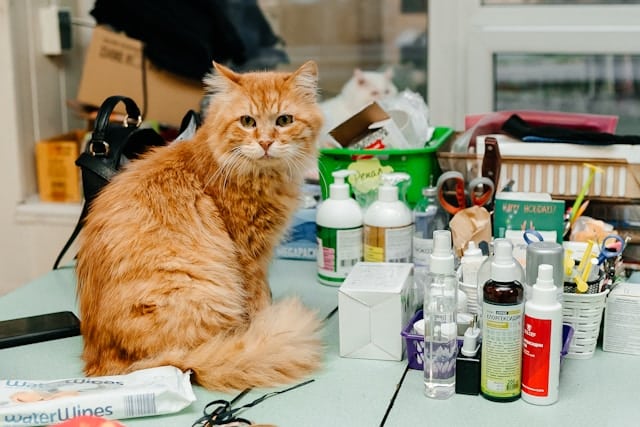As pet owners, you always want your beloved companions to be in the best of health. Often this means regular check-ups at the vet. However, for our feline friends, a trip to the veterinary clinic can be a source of undue stress and anxiety. So how can you, as cat owners, make these necessary visits less stressful for your pet? In this article, we provide some practical methods to help reduce the stress your cat might feel during a visit to the vet. We will also give pointers on how to make the use of a carrier less intimidating for your pet, how to create a calm environment at the vet’s practice, and offer tips on reducing stress during the journey to the vet.
Choosing the Right Carrier
To some cats, the sight of a carrier can be a clear signal that a stressful event, like a vet visit, is imminent. Therefore, choosing a carrier that your cat feels safe in is of utmost importance.
A voir aussi : What Are the Best Non-Invasive Pain Management Techniques for Elderly Cats?
When selecting a carrier, consider one with multiple openings that easily allow your cat to enter and exit. A removable top can give your vet easy access to your pet during the examination, reducing the need to forcefully remove them from the carrier.
Another factor to consider is the stability of the carrier. A carrier with a sturdy base can make your cat feel more secure during transport. Also, cats feel comfortable in smaller spaces, so make sure the carrier is not too big.
Lire également : How to Properly Insulate a Rabbit Hutch Against Extreme Cold Temperatures?
Acclimating your cat to the carrier is equally important. If the carrier appears only during a vet visit, your cat may associate it with stressful situations. To prevent this, keep the carrier as an open fixture in your home. Let them explore it, sleep in it, and play around it. This can help them associate the carrier with safety and comfort, rather than fear and stress.
Creating a Calm Environment at the Vet’s Practice
A veterinary clinic can be a hub of activity, with other animals, unfamiliar smells, and strange noises. This sensory overload can be stressful for your cat. However, there are ways to make the waiting room experience less stressful for your pet.
First, ask if your veterinary clinic has a separate waiting area for cats. This can keep your cat away from potentially frightening interactions with dogs. If this is not available, keep your cat in their carrier, elevated off the floor, to create a sense of security.
If possible, schedule your visits at off-peak times when the clinic is less busy. This can minimize the exposure your cat has to other animals and noise, reducing potential stressors.
Reducing Stress during the Car Journey
The car ride to the vet can also be a source of stress for your cat. However, there are strategies you can employ to help alleviate this stress.
Start by acclimating your cat to the car. Take them on short, non-vet related trips. Make sure to reward them with treats or praise after every car ride. This can help them associate the car with positive experiences.
Use calming pheromones in the car. These synthetic pheromones mimic the facial pheromones that cats use to mark their territory, providing a sense of familiarity and security.
Finally, secure the carrier in the car. A loose carrier can slide and shift during the ride, causing stress to your cat. Securing the carrier can provide stability and help your cat feel safer.
Training and Conditioning Your Cat
Training and conditioning can be effective strategies to help reduce your cat’s stress during vet visits. Familiarizing your cat with the procedures it might encounter at the vet can help reduce uncertainty and fear.
Gradually get your cat used to being handled. Touch and lift your cat in the same way a vet might during an examination. This can help them become comfortable with the sensation and reduce stress during the actual vet visit.
Pair these handling exercises with rewards to create positive associations. Over time, your cat may learn to associate the sensations of a vet exam with the rewards, reducing stress and fear.
Remember, the goal isn’t to eliminate stress completely, but to manage and reduce it to a tolerable level for your cat. With patience, understanding, and a little bit of training, vet visits can become less stressful experiences for both you and your pet. Remember, your cat looks up to you for comfort and reassurance, so staying calm and composed yourself can greatly help in reducing your cat’s anxiety during these trips.
Encouraging Fear-Free Vet Visits: The Role of Veterinary Practices
While the onus of preparing a cat for a less stressful vet visit lies largely with the owner, the veterinary practice can also play a pivotal role in fostering a fear-free environment. A few changes in the way the clinic operates can significantly reduce stress in your cat during veterinary visits.
Cat-friendly clinics are becoming increasingly popular. These clinics are designed specifically to meet the unique needs of cats. They offer separate waiting rooms for cats and dogs, minimizing the stress of potential encounters between these two species. The examination rooms in these clinics are also equipped specifically for cats, with cozy, quiet spaces that help cats feel secure.
In addition, these clinics train their staff to handle cats gently and empathetically. They use low-stress handling techniques and understand the signals that cats give to convey stress or discomfort. This knowledge can help them adjust their approach to make the vet visit as stress-free as possible for your cat.
While not all veterinary practices may have the resources to become completely cat-friendly, they can still implement changes that can help reduce stress in cats. For instance, they can schedule cat vet appointments at specific times of the day when there are no dogs around. They can also provide a separate waiting area for cats. If separate waiting rooms are not feasible, they can at least keep cats and dogs at opposite ends of the waiting room.
Conclusion: Ensuring a Positive and Stress-Free Vet Experience for Your Cat
Reducing stress in your cat during veterinary visits can make a significant difference in your pet’s overall health and wellbeing. While it might seem daunting initially, with consistency and patience, it is very much achievable. The key is to familiarize your cat with the various aspects of a vet visit – the carrier, the car ride, the waiting room at the vet’s office, and the examination itself – in a gradual and positive manner.
Remember, your cat feeds off your energy. If you are calm and composed, it can help them remain calm too. By making the carrier a safe and comfortable space, acclimatizing your cat to car rides, encouraging a calm waiting room environment, and practicing handling exercises at home, you can prepare your cat for a less stressful vet experience.
As a pet owner, your role is crucial. But remember, you are not alone in this journey. Veterinary practices today understand the importance of fear-free vet visits and many are making changes to their practices to accommodate the unique needs of cats. Together with your vet, you can create a positive and stress-free vet experience for your feline friend.
Reducing stress during vet visits is not just about making a single visit pleasant for your cat. It is about ensuring that your cat remains comfortable with vet visits in the long run. With a little effort, you can help make vet visits a less stressful experience for both you and your cat.











